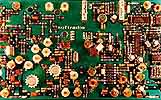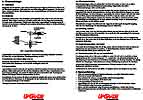Digital Radio - Wireless LANs
BACKGROUND INFORMATION
In many places it is impossible, or not desirable to use physical
cabling for a local area network.
- If the company premises are in a house of cultural interest or a museum, maybe you are not allowed to drill
holes in the walls.
- If the company has two premises separated by a road, it is not possible to lay a network across it.
- On temporary premises, like for example building sites, it may be difficult to establish a permanent network.
- If the network is to be extended to mobile units, like forklifts in a warehouse, cranes in a harbour, service
cars at an airport etc., permanent cabling is impossible.
- Many municipalities in Sweden run on a low budget, and have to limit all costs. At the same time they have
to keep up with the pace of technology, and connect all offices, schools and libraries to a network and to the
Internet. Having to pay the telecommunications authority for leased lines between the offices, would quickly tip
the budget over.
- Wireless networks are now standardised and the prices are falling. In some cases it would be possible to avoid
all cabling and choose a wireless solution from the beginning.
- On premises where the workstations are moved time after time, cabling may become impractical, for example in
large supermarkets, where temporary POS terminals are set up and moved at regular intervals, in exhibition halls
etc.
In these cases, a wireless network may be the solution. The users, at their workstations, will not know if they
are connected to the network by cable or if the network is distributed via radio.
I have been dealing with radio based networks for a long time, although from the beginning it was only experiments.
 Exciting things happened at the Linköping
Technical Institute (LiTH) in the beginning of the 80's: wireless computer networks. It was something new. The
network was distributed on the 432 MHz amateur radio band, and everyone who wanted to join in could buy a kit.
LiTH had symposia and there was a sister club founded in Stockholm. We built day and night and programmed the client
computers in Forth language, which was new and exciting then. Above all it was fast and compact and memory-saving.
Exciting things happened at the Linköping
Technical Institute (LiTH) in the beginning of the 80's: wireless computer networks. It was something new. The
network was distributed on the 432 MHz amateur radio band, and everyone who wanted to join in could buy a kit.
LiTH had symposia and there was a sister club founded in Stockholm. We built day and night and programmed the client
computers in Forth language, which was new and exciting then. Above all it was fast and compact and memory-saving.
We had plans on regional networks in the big cities and backbone networks between the larger cities. At the
time, the project was scrapped because of lack of time, but today it is realised commercially, and is called “the
GSM network.”
Commercial, General Purpose Networks
|
Semiconductor technology today allows us to build and mass-produce compact radio units for the microwave bands.
A new cadre of companies has been profiting on this and started manufacturing small, reliable radio LAN units for
the ISM bands (Industry, Science and Medicine) on 2.4 and 5.8 GHz. There is bandwidth enough available for transmissions
speeds of 3, 10 and shortly also 50 Mb/s.
Various types of frequency hopping, so called spread spectrum technology, are used partly to make eavesdropping
more difficult, and partly so that two stations close to each other will not interfere.
The system has two main areas of use: for connecting stationary and mobile units to a network, and for linking
together several networks at large distances.
The types of antennas used for digital radio differ very little from antennas for TV or GSM telephony, but the
rooftop mounting should not be left to the local TV-antenna company, as they usually lack the necessary knowledge
about commercial antenna installations, microwaves, grounding, ligthning protection etc. TV sets are not as sensitive
to electrical athmospheric phenomena as digital transmitters.

 The pictures shows a (Swedish)
policy leaflet I made as a suggestion for Upgrade AB, to be packed with all digital radio products, after all the
problems encountered with less knowledgeable antenna technicians. There have been cases where a change in weather
has created current pulses in the radio equipment of such magnitude that it destroyed not only the microwave parts.
A router, located in the cellar, was also completely burnt out. This area of technology is intimately connected
with EMI, being dealt with here.
The pictures shows a (Swedish)
policy leaflet I made as a suggestion for Upgrade AB, to be packed with all digital radio products, after all the
problems encountered with less knowledgeable antenna technicians. There have been cases where a change in weather
has created current pulses in the radio equipment of such magnitude that it destroyed not only the microwave parts.
A router, located in the cellar, was also completely burnt out. This area of technology is intimately connected
with EMI, being dealt with here.
 The article below made great impact, both in Sweden and abroad. Commissioned by the Swedish magazine
Nätverk & Kommunikation, I tested and compared several different wireless LANs, measured transmission
speeds and criticised the installation procedures. Of course the Israeli BreezeCom came out happiest, as they ran
in circles around their competition in most respects.
The article below made great impact, both in Sweden and abroad. Commissioned by the Swedish magazine
Nätverk & Kommunikation, I tested and compared several different wireless LANs, measured transmission
speeds and criticised the installation procedures. Of course the Israeli BreezeCom came out happiest, as they ran
in circles around their competition in most respects.
If you click on the links below, you may read the full article. Please be patient; the files are between 150
and 250 kB in size.
Article page 1
Article page 2
Article page 3
Article page 4
Article page 5
Article page 6
Article page 7

 Exciting things happened at the Linköping
Technical Institute (LiTH) in the beginning of the 80's: wireless computer networks. It was something new. The
network was distributed on the 432 MHz amateur radio band, and everyone who wanted to join in could buy a kit.
LiTH had symposia and there was a sister club founded in Stockholm. We built day and night and programmed the client
computers in Forth language, which was new and exciting then. Above all it was fast and compact and memory-saving.
Exciting things happened at the Linköping
Technical Institute (LiTH) in the beginning of the 80's: wireless computer networks. It was something new. The
network was distributed on the 432 MHz amateur radio band, and everyone who wanted to join in could buy a kit.
LiTH had symposia and there was a sister club founded in Stockholm. We built day and night and programmed the client
computers in Forth language, which was new and exciting then. Above all it was fast and compact and memory-saving.

 The article below made great impact, both in Sweden and abroad. Commissioned by the Swedish magazine
Nätverk & Kommunikation, I tested and compared several different wireless LANs, measured transmission
speeds and criticised the installation procedures. Of course the Israeli BreezeCom came out happiest, as they ran
in circles around their competition in most respects.
The article below made great impact, both in Sweden and abroad. Commissioned by the Swedish magazine
Nätverk & Kommunikation, I tested and compared several different wireless LANs, measured transmission
speeds and criticised the installation procedures. Of course the Israeli BreezeCom came out happiest, as they ran
in circles around their competition in most respects.